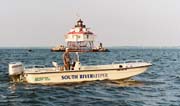|
||||||||
Lone Rangers in Powerboats
|
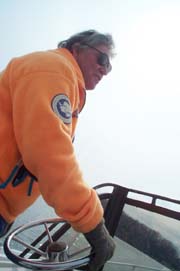 |
|
‘I grew up fishing for yellow perch on the Severn. Now, yellow perch are wiped out by pollution and loss of habitat,’ says Severn Riverkeeper Fred Kelly. |
Water patrol doesn’t stop for the winter. A sunny, cool, late March day brought Fred Kelly — wearing a bright orange fleece — out on the Severn. He stopped in front of a large window-flanked house perched on the top of a steep, clear-cut embankment.
“That’s my poster child for the Critical Area Law,” he said, gazing upon one of many homes that paid the fine for the view it enjoys.
Maryland’s Critical Area Law is the golden rule of riverkeepers. Under this law around the Bay basin, the land spanning 1,000 feet from the mean high water line is sacred. Landowners have to follow specific regulations as they build and cut trees and shrubs, especially within 100 feet of the water line. Residents can apply to be exempted from the law, a request that riverkeepers agree is granted much too frequently.
If waterfront dwellers clear-cut a view, fell trees or violate another provision without the okay from the county, they get fined.
Last year, Kelly fought to increase that fine for outlaws.
“Maximum critical area fines were $500. The law was a joke,” says Kelly, who’s been keeping the Severn for some four years. “I wanted it raised from $500 to $10,000, the penalty in 1898. Back then it was the Refuse Act, where people were charged $10,000 for polluting.” He got his wish, and Anne Arundel County upped its fines. Outlaws now pay on a sliding scale that climbs to $10,000.
In one form or another, it’s such disregard for the waterways that Kelly fights day by day.
Kelly, a stout man with graying hair, cop sunglasses and a golden retriever, doesn’t cut any slack when it comes to protecting the river. When he gets passionate about environmental codes, his voice drops to balance out equally passionate words. He’s not afraid to name names.
“This county has a horrific track record with not protecting our waterways,” he says, naming county employees who he feels let environmental integrity fall slack.
Because of his job, he knows as much about environmental laws as any state or county bureaucrat; probably more.
Starting as an unpaid riverkeeper, Kelly took a big salary cut from working in Annapolis as, he says, a “classic small-town lawyer who did everything and was very financially successful.” This is his first year with a full-time riverkeeper salary.
Now he’s seeking more lawyers to work pro bono for the Bay. His fledgling program Lawyers for the Bay would match up lawyers with environmental groups that need legal representation. Perhaps, like him, they’ll come because nature has its own laws.
“The reason I’m a riverkeeper,” Kelly explains, “is because I grew up fishing for yellow perch on the Severn.” Those younger generations of yellow perch lay eggs at the start of Saltworks Creek, the creek his own waterfront home now sits on.
“Anne Arundel County planning and zoning supported development at the head of Saltworks,” he said. “Reproduction of yellow perch is wiped out by pollution and loss of habitat.”
That development, Monticello by K Hovnanian Homes, drew Kelly in because of its sediment runoff problems. But the developer listened to the Severn riverkeeper, taking sediment-control measures and sending in heavy equipment to remove “eight giant oil tanks sitting in Saltworks Creek,” Kelly says.
Another recent project he and his riverkeeper program lassoed was a pump-out station proposed for the docks at Severn Inn. It would, he argued, have overwhelmed their septic system and released raw sewage into the river.
“I interact very closely with the Severn River watershed people to stop inappropriate development and oxygen depletion,” Kelly explained.
“I’m empowering people who care about the Severn,” he says, “giving them a voice.”
West and Rhode Riverkeeper Bob Gallagher
Getting the community behind us
Getting rid of a 20-ton, sunken, rusty barge half the size of a football field wasn’t written on the job description. Neither was knocking on neighbors’ doors to complain about their latest dockside addition.
But for the lone riverkeeper — on these occasions Bob Gallagher — these calls c
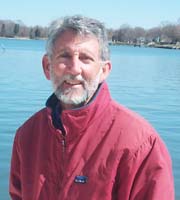 |
|
‘We have to convince officials that we take this seriously,’ says Bob Gallagher, Riverkeeper for the West and Rhodes rivers. |
ome with the territory.
Still another group called on him one chilly, mid-March evening as an advisor to a fledgling environmental group of nine Fairhaven neighbors. They gathered in a cozy Bay-front home before a crackling fireplace and a dark picture window looking out over evening waters.
“I’m convinced that the only way for us to succeed is to have an active watershed group in each watershed,” says Gallagher, a middle-height man with a short grey beard, baseball cap and — this cool night — a heavy fleece embroidered with his West/Rhode Riverkeeper logo. Before his days of riverkeeping, he was a civil rights and pension litigator in Washington, D.C.
At the March meeting, Fairhavener Kathy Gramp asked if it was hard to find cases to pursue with all the hundreds of small pieces of development.
“We don’t have any big industry, no Exxon-Valdez,” he says. There are no giants for Gallagher to battle in his territory. “But I look for big cases. Developers have more money than we do, so I look for cases that have a wider impact to get more bang for the buck.”
Looking for efficient ways to protect the river with limited dollars takes planning and strategy.
“We have to convince officials that we take this seriously,” Gallagher says. “It’s not just the bad guys. A lot of times it’s the government.”
“So you can make a difference by calling and writing” to reach public officials, said Fairhaven neighbor Barbara Miller.
“At every level, they’re turning back regulations to protect the environment. You can make it so uncomfortable for them that they back off,” Gallagher says. “The long-term tool is getting legislators to wake up.” Especially when it comes to development, he says, “we can always turn out more people than they can.”
The fledgling group also wanted to know how to find out about a tract of land between Rose Haven and Fairhaven, so they could help protect it.
“Find out who owns it. There’s easements that can stop development,” says Gallagher, while benefiting the landowner.
Part of the job of a riverkeeper is sleuth work, which Gallagher’s learned along the way.
“In the fall of 2004, I got the idea to do this,” Gallagher said about the Riverkeeper program. “I talked to community groups to find out if I was duplicating anyone else’s work.”
Late 2004 brought a non-profit proposal, followed by official non-profit status in early 2005; up until November he’d paid for everything himself. As with Kelly, getting a salary took time. January of this year brought his first full-time riverkeeper paycheck: $500 each month.
With funding has come the momentum to tackle bigger and more important issues.
“One of our biggest issues is the Critical Area Law, and we have a couple examples of egregious violations,” says Gallagher, who says rather than litigate, he’d much rather talk to home and business owners to resolve violations.
“People are receptive, but no one likes someone sticking their nose in it,” he says. “The way I read the law, you can’t build in the first 100 feet unless you get a variance.” Even then, over 86 percent of variances are granted, laments Gallagher to the Fairhaven group. “I think that’s wrong,” he says.
To help combat the effects of so much development, Gallagher is coordinating a living shoreline restoration on a piece of Anne Arundel County-owned property that’s now plagued with erosion problems.
Another idea is to get funding for a pump-out boat to remove wastewater from private boats for a low fee, so their waste doesn’t end up in the river.
Water quality rides high on Gallagher’s radar.
“The West and Rhode were just listed as impaired rivers from PCBs. No one knows where it comes from,” he says, though he suspects old transformers on telephone poles, grandfathered in past environmental health laws.
But all his work depends on people. Involving the community — even here in this small group — is the riverkeeper’s way of turning environmental ideas into reality.
“The most important thing is getting the community behind us,” says Gallagher. “We can do all the shoreline restoration we want, but it’s not going to save the Bay,” he says, without a community that cares.
South Riverkeeper Drew Koslow
Rounding up pollution and solving mysteries
One cloudy Saturday morning in early April brought South Riverkeeper Drew Koslow and a small army of 15 volunteers to rescue a South River tributary.
Church Creek runs through a small parcel of land bounded by Route 2, Outback Steakhouse and Forest Drive. Volunteers worked in the ravine below the Home Depot parking lot, where customers bustled in and out, casting curious glances toward the commotion near the creek.
Volunteers gathered to fill trash bags and haul junk — three truckloads in all fo
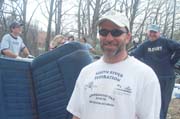 |
|
‘One person can’t do anything, but when we all get together, rivers get cleaner,’ says South Riverkeeper Drew Koslow at the clean up. |
r a big, bright orange county dump truck to carry to the landfill. At the end of their three-hour clean up, they’d brought up piles of cast-off items, all of which they dragged up a steep 30-foot embankment.
“This sends a message to all the people driving by,” said volunteer Dan Ross.
Besides the typical soda cans and glass bottles, volunteers retrieved lamps, mattresses, an old fridge, car batteries, a jug of antifreeze, an electric fan, a 15-passenger van seat, a shopping cart, a lawnmower, some 15 tires and a Body by Jake Bun & Thigh Rocker.
“This part of Church Creek used to be so clean that Coca-Cola used it for bottling,” said volunteer and environmental leader Anne Pearson. “Every year they do this clean up.” Pearson, founder of the Alliance for Sustainable Communities, is among South River volunteers that returns annually to pick up tons of new trash. “What impresses me is people don’t know because they don’t see this devastation,” she says.
What would really make a difference on this spot is for Home Depot to put up a fence, so people couldn’t just dump their trash over the side of the ravine into the creek site that Koslow’s crew cleans up year after year.
Church Creek’s development-locked land parcel is one of four sites that Koslow has organized to get tributaries cleaned up.
Dressed in a once-white T-shirt, work gloves and worn jeans, Koslow, a gentle riverkeeper with a deliberate manner, worked alongside his volunteers, pitching a rusty gutter into the orange county truck, saying, “Anyone need some gutter?”
Trained as a biologist and wetlands scientist, Koslow says he has the technical skills to talk to both scientists and lay people. As a biologist at DNR, Koslow was already active in the South River Federation, which organized the river keeper search. He beat out more than 40 applicants to be the first riverkeeper tasked with keeping the South River clean.
Such a cleanup is an example of how communities can move mountains — and not just mountains of trash.
“I love empowering other people. One person can’t do anything, but when we all get together,” says Koslow, rivers get cleaner. Last year he had a team move 400 or 500 tons of rock to break wave energy threatening a living shoreline. “It’s about quality of life. About doing something positive.”
All’s not positive in Koslow’s territory, however. Waiting for the country dump truck to return, Koslow told volunteers that county water quality monitoring reveals some 62 carcinogens in Church Creek, including heavy metals and PCBs.
Like his fellow riverkeepers — whom he works closely with on bigger issues like getting legislation passed — Koslow regularly patrols the South River and keeps tabs on what’s happening.
He looks out for some 53 miles of shoreline in the South River, he reported in his riverkeeper’s log last year.
From his inspections, he’s prioritized two big projects. First is solving a mystery: why catfish in the South River are coming up sick. Second is restoring shoreline.
“One of the biggest things is figuring out what’s going on with the catfish that were found to have a high cancer rate and figuring out where this is coming from and how to get it cleaned up,” he explains.
The cancerous fish were caught in a U.S. Fish & Wildlife study, paid for by the South River Federation. The state researchers caught a random sample of 30 fish, all around four years old.
“About half of the fish we looked at had skin cancer around the mouth; 20 percent had liver cancer,” Koslow says.
Clues to what’s behind the cancer are found by research in other rivers like the Anacostia, where a U.S. Fish & Wildlife scientist has linked similar cancers in the same kind of catfish to runoff, unburned fossil fuels and polycyclic aromatic hydrocarbons in the water.
“There’s high cancer rates but we weren’t able to say definitively what the cause is,” says Koslow, whose group is raising money to do the rest of the testing. “We’re hoping the government comes through with the funding.”
His other big project is another volunteer effort, like the stream cleanup. That shoreline — some 300 to 400 feet long — will require dozens of volunteers to plant grasses, move rocks and get wet.
The USS Submarine Maryland is supplying many of the volunteers he needs. The Blue Crew from a nuclear submarine based out of King’s Bay, Georgia, will follow Navy tradition as they come to their boat’s namesake state to work for communities three to four times a year for a week at a time. They’ll join over 50 community volunteers.
“We’re doing a living shoreline project with the crew May 1 to 4,” he says. Edgewater Beach is one of about six shorelines that he’s helped restore during his time with the South River Federation.
In that time, he reports, “We’ve restored almost a linear mile of shoreline.”
Patuxent Riverkeeper Fred Tutman
Building connections to the river
Earlier this year, Patuxent Riverkeeper Fred Tutman was wading deep into the state legislature. He was working on bills that would make his watershed — which drains some 900 miles of land in portions of St. Mary’s, Calvert, Charles, Anne Arundel, Prince George’s, Howard and Montgomery counties — cleaner and healthier.
One of those bills that made it through the legislature, with Del. Sue Kullen and Sen. Roy Dyson merging bills to cap nutrients spilling from wastewater treatment plants into the Patuxent. But, Tutman laments, it was severely weakened in the amending process.
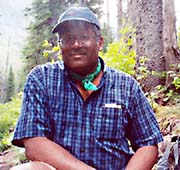 |
|
‘I want to help people build a sense of connection to this river,’ says Patuxent Riverkeeper Fred Tutman. |
“They were heavily compromised,” says Tutman, who met with environmental giants and former Sen. Bernie Fowler to help formulate the bill. “It was amended to mirror the Flush Fee, which isn’t going to clean up the Bay. It’ll reduce nitrogen loading, but it won’t bring back crabs or the Bay grasses.” So the intentions of the sponsoring lawmakers washed downstream, Tutman says.
Next year, he’ll push a bill to put performance benchmarks on how the state does stormwater permitting.
“Now, builders are required to do things in concept [to keep stormwater runoff clean] but those procedures often fail,” Tutman explains. “If you build in a way that’s green, with minimum impact, it’s cheaper and you don’t have to pass those costs on.”
Tutman — who’s one year away from a law degree from the University of Southern California — comes from riverside lineage in the Queen Anne region of Prince George’s County.
“I didn’t even know that riverkeepers existed until, to be exact, the day the re-entering space shuttle blew up over the Southwest,” says Tutman, who’s been a riverkeeper since June 2004. “I was at a meeting and somebody handed me a story about the Hudson River folk who worked to get the legal river protections enforced.”
That’s when he realized how one person could protect a river.
“I got the idea that grass-roots stuff could be important on a large scale. So I called up the Waterkeeper’s Alliance to see if the Patuxent River had a riverkeeper. It didn’t,” said Tutman. The only African American riverkeeper in Maryland, he is a man of medium-build with gray hair, mustache and a round face animated by his high-energy pace. “I decided to make an application.”
He came to keep the Patuxent River from a background in media and communications.
Along with running his media business, he’d been chairing a local Patuxent River community group that had been founded in the 1970s, he says, “by folk who lived and breathed saving this river.”
Riverside communities are of Tutman’s greatest concerns. He’s sensitive to projects that improve environmental justice, to the way that pollution, or even cleanup of the river, affects communities of different economic backgrounds.
To better reach out to communities that aren’t typically in the environmental loop, Tutman is organizing a Spanish-speaking program.
“Hispanic folks are occupying a growing sector in our watershed. These are folks that eat finfish and eat what they catch. They need to be aware of concerns about eating fish,” he said. “Most non-minority people are appalled that people would eat what comes out of the river. So there’s populations that are very much at risk.”
Tutman’s dream for the Patuxent — one shared by most riverkeepers for their own watersheds — includes building a river community. He’d like to see more people get to know the river, through smells and sounds, wildlife and recreation.
“The community has to do things for the river,” says Tutman. “I want to help people build a sense of connection to this river.”
Sara E. Leeland contributed to Tutman’s profile.
© COPYRIGHT 2004 by New Bay Enterprises, Inc. All rights reserved.


